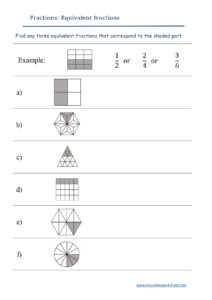Solving for x with fractions
Solving for x with fractions
How do you solve for x in a fraction equation?
Solving for � in a fraction equation is very similar to solving for � in any other type of equation. The key is to isolate � on one side of the equation. Here are the general steps to follow:
-
Clear Fractions (if necessary):
- If the equation contains fractions, it’s often helpful to clear the fractions first. To do this, multiply both sides of the equation by the least common denominator (LCD) of all the fractions in the equation. This will eliminate the fractions.
- Simplify the Equation: After clearing fractions (if necessary), simplify the equation as much as possible. Combine like terms on both sides.
- Isolate �: Move all terms containing � to one side of the equation and constants to the other side. Use inverse operations to isolate �. Here are some common examples:
- If there’s addition or subtraction involving �, perform the opposite operation (subtraction or addition) to both sides of the equation.
- If there’s multiplication or division involving �, perform the opposite operation (division or multiplication) to both sides of the equation.
- Simplify Further: If needed, simplify the equation further after isolating � to get it into its simplest form.
- Check Your Solution: Always check your solution by plugging it back into the original equation to ensure it satisfies the equation. Sometimes, solutions can be extraneous and not valid for the original equation.
Here’s an example to illustrate these steps:
Example: Solve for � in the equation 2�3−4=5.
- Clear Fractions: The fraction in this equation is 2�3, so multiply both sides by 3 to clear the fraction:
2�3⋅3−4⋅3=5⋅3
This simplifies to 2�−12=15.
- Simplify the Equation: Combine like terms:
2�−12=15
- Isolate �: Add 12 to both sides to isolate 2�:
2�−12+12=15+12
2�=27
- Simplify Further: Divide both sides by 2 to isolate �:
2�2=272
�=272
- Check Your Solution: Plug �=272 back into the original equation to verify it:
2⋅2723−4=5
273−4=5
9−4=5
5=5
Since the equation is satisfied, the solution is �=272.

“Learn how to solve for the variable ‘x’ in fraction equations step by step.
This comprehensive guide explains the process, including clearing fractions, isolating ‘x,’ and verifying solutions. Whether you’re tackling basic algebraic expressions or more complex equations, this tutorial provides clear instructions and examples to help you master the art of solving fraction equations effortlessly.
- Clear Fractions (Optional): If the equation contains fractions, you can start by clearing the fractions. To do this, multiply both sides of the equation by the least common multiple (LCM) of the denominators. This step is optional but can make the equation easier to work with.
- Simplify (if needed): Simplify both sides of the equation as much as possible by performing any necessary operations. This might involve combining like terms or simplifying fractions further.
- Isolate x: To isolate x, perform inverse operations to move all the terms containing x to one side of the equation and the constants to the other side. The specific operations will depend on the equation. Here are some common examples:
- Addition or subtraction: If there are terms with x on both sides of the equation, you can add or subtract terms to get all the x terms on one side.
- Multiplication or division: If there is multiplication or division involving x, you can undo these operations by performing the opposite operation. For example, if x is multiplied by a number, divide both sides by that number.
- Simplify Again (if needed): After isolating x, simplify the equation again if necessary to make it as simple as possible.
- Check Your Solution: Once you have an equation with x isolated on one side, make sure to check your solution by plugging it back into the original equation. If it satisfies the equation, then it is the correct solution. If it doesn’t, recheck your steps and calculations.
Here’s an example to illustrate these steps:
Example: Solve for x in the equation (3/5)x + 2 = 7

